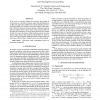Free Online Productivity Tools
i2Speak
i2Symbol
i2OCR
iTex2Img
iWeb2Print
iWeb2Shot
i2Type
iPdf2Split
iPdf2Merge
i2Bopomofo
i2Arabic
i2Style
i2Image
i2PDF
iLatex2Rtf
Sci2ools
90
Voted
ICASSP
2011
IEEE
2011
IEEE
Directionality-based speech enhancement for hearing aids
In this work we describe methods for using the directionality of sound energy as a criterion to estimate single- and multichannel linear filters for suppression of diffuse noise and reverberation in a hearing aid application. We compare conservative strategies where direction of arrival is unknown, and more aggressive strategies where the proposed methods can be used to derive a fast acting post-filter for the output of a beamformer. We show that in situations where a target of interest is near to the listener while interfering sources are more distant, simple features that capture the directionality of sound energy can be used to attenuate significant undesired signal energy and can be more effective than a strategy based on noise-floor tracking.
Hearing Aid Application | ICASSP 2011 | Multichannel Linear filters | Signal Processing | Sound Energy |
| Added | 20 Aug 2011 |
| Updated | 20 Aug 2011 |
| Type | Journal |
| Year | 2011 |
| Where | ICASSP |
| Authors | John Woodruff, DeLiang Wang |
Comments (0)

